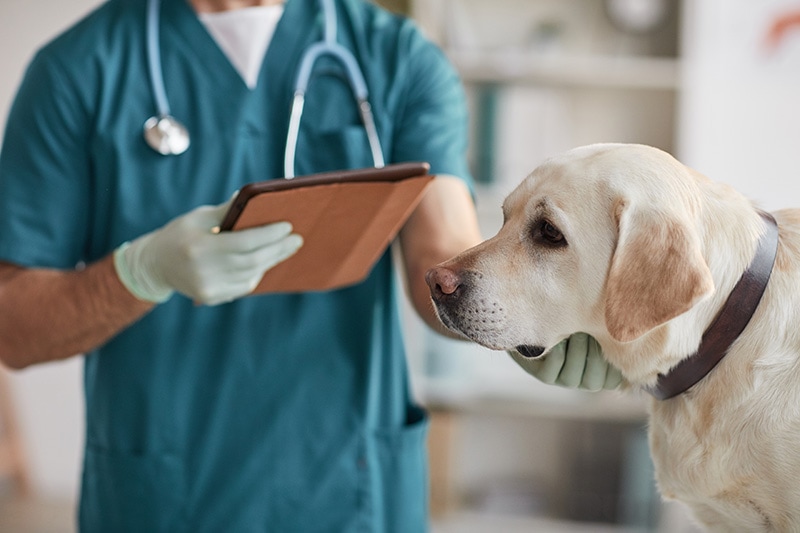Amoxicillin for Dogs: Usage, Dosage & Safety (Vet Answer)

Updated on

Click to Skip Ahead
Amoxicillin is a commonly used antibiotic for dogs. It is a broad-spectrum drug effective against a wide range of bacteria. It is relatively safe with minimal side effects reported. A veterinary prescription is required, and it must never be used without veterinary direction.
What Is Amoxicillin?
- Urinary tract infections
- Skin infections and wounds
- Abscesses
- Respiratory tract infections
- Kidney infections
This is the same type of medicine as penicillin; however, it is more resistant to stomach acid so is better absorbed into the body. Amoxicillin has a broader spectrum of activity compared to penicillin.
Amoxicillin works by targeting and hindering the growth of susceptible bacteria. It works by preventing the bacteria from producing a vital part of their structure in the cell wall. This weakens the bacteria and causes it to die.
Amoxicillin is considered to be a broad-spectrum antibiotic. This means it can be used to treat a wide range of bacteria including both gram-positive and gram-negative types. It is often prescribed to treat bacterial infections caused by E. Coli, Staphylococcus aureus, Streptococcus spp., and Proteus mirabilis, as well as many others.
- Amoxil
- Amoxi-Tabs
- Amoxi-Drip
- Bimox
- Moxatag
- Novamoxin
Amoxicillin can be combined with clavulanic acid in tablets especially formulated for animals. This means the medication offers a broader spectrum of activity. The clavulanic acid is added to amoxicillin to give protection against enzymes that can potentially destroy Amoxicillin before it has managed to kill any bacteria.
Amoxicillin tablets must be stored at room temperature, ideally between 59 and 86 degrees F. The reconstituted form needs to be sorted in the fridge and used within 14 days. After this time, it has to be discarded. Ensure the drug is kept away from direct sunlight or any source of moisture, and keep it out of reach of children and pets.

How Is Amoxicillin given?
Amoxicillin usually comes in a tablet form, a capsule, or a liquid suspension. There are also injectable forms that your vet may use in practice, but owners aren’t prescribed these to administer at home. The liquid suspension must be shaken gently before use to mix the solution.
Amoxicillin is dosed depending on your dog’s weight. Your vet will be able to calculate a dose when they weigh your dog. Owners must never dose their dogs at home without following veterinary advice. The medication starts working relatively quickly in 1–2 hours. Resolution of clinical signs takes a longer amount of time.
Amoxicillin can be given with or without food, but some dogs tolerate the medication better when it is given with food. Occasionally vomiting is seen if it is given on an empty stomach.
What Happens if You Miss a Dose?
If you miss a dose of amoxicillin, speak to your vet for advice. In general, it is okay to give the missed dose as soon as you remember. However, if it is close to the time of the next dose, your vet will advise you to miss the dose and then give the next dose as intended.
Never give double doses or any extra doses that haven’t been prescribed. If you continually miss doses this will mean the course of antibiotics won’t work as well. It is important to try and keep to the prescription.

Potential Side Effects of Amoxicillin
All antibiotics can cause side effects. Some are mild and transient; others are more serious and will require stopping and changing the antibiotics.
- Reduced Appetite
- Lethargy
- Watery eyes
- Fever
- Vomiting
- Diarrhea
- Skin rash
- Hives
- Itchiness
Prolonged usage can cause kidney and liver issues in some dogs, and some dogs can experience allergic reactions to Amoxicillin.
- Breathing difficulties
- Facial swelling
- Rash
- Seizures
- Anaphylaxis
Owners should note that while these are listed as common side effects, in general, side effects from Amoxicillin are rare.
Frequently Asked Questions (FAQ)
1. What should I do if my dog has had an overdose of Amoxicillin?
A one-off overdose of Amoxicillin is unlikely to cause toxicity. Prolonged overdose may cause clinical signs such as vomiting, diarrhea, and loss of appetite. If a large amount has been given as an overdose, more serious clinical signs such as kidney disease and seizures may be seen. If you think your dog may have had an overdose of Amoxicillin, consult your vet immediately for advice.
2. Can I give my dog human amoxicillin?
It is never advised to give your dog human Amoxicillin. Human medications may have different formulations and dosages that are not suitable for dogs. Your vet should always be your first port of call for advice if your dog is sick. You should never use medication you have at home to treat your dog.

3. How long should my dog take amoxicillin for?
The duration of the course of amoxicillin given to your dog depends on what is wrong with them and how severe it is. Your vet will give you clear instructions on what to give your dog and how many days to treat them. Always follow your vet’s instructions and make sure you finish the course of medication, even if your dog seems better before the course has ended.
Conclusion
Amoxicillin is a commonly used antibiotic. Its broad spectrum of activity and ease of administration make it a useful medication. It is most typically used to treat skin, respiratory, and urinary tract infections. Amoxicillin is well tolerated by the majority of dogs.
However, like all other antibiotics, it can cause side effects. These are usually mild and short-lived. Your vet will be able to advise you on appropriate usage for your dog.
Featured Image Credit: Creative Cat Studio, Shutterstock














